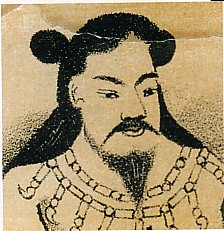Emperor Itoku
Emperor Itoku (懿徳天皇, Itoku-tennō) was the 4th emperor of Japan,[3] according to the traditional order of succession.[4] Historians consider Emperor Itoku to be a legendary person,[5] and the name Itoku-tennō was created for him posthumously by later generations.
| Itoku | |||||
|---|---|---|---|---|---|
 | |||||
| Emperor of Japan | |||||
| 510 BC – 477 BC (traditional)[1] | |||||
| Predecessor | Annei | ||||
| Successor | Kōshō | ||||
| Born | 553 BC[2] | ||||
| Died | 477 BC (aged 76) | ||||
| Burial | Unebi-yama no minami no Manago no tani no e no misasagi (畝傍山南纖沙溪上陵) (Kashihara) | ||||
| Spouse | Amonotoyototsu-hime | ||||
| Issue | |||||
| |||||
| House | Imperial House of Japan | ||||
| Father | Emperor Annei | ||||
| Mother | Nunasoko-Nakatsu-hime | ||||
| Religion | Shinto | ||||
No certain dates can be assigned to this emperor's life or reign.[6] The conventionally accepted names and sequence of the early emperors were not to be confirmed as "traditional" until the reign of Emperor Kammu, who was the 50th monarch of the Yamato dynasty.[7]
The Gukanshō records that he ruled from the palace of Migario-no-miya at Karu in what will come to be known as Yamato province.[8]
Traditional history
Itoku is almost certainly a legend. The Kojiki records only his name and genealogy. The Nihonshoki includes Itoku as the third of "eight undocumented monarchs" (欠史八代,, Kesshi-hachidai).[9]
The Gukanshō records that Itoku was the second or third son of Emperor Annei,[8] but the surviving documents provide no basis for making guesses about why the elder brother or brothers were passed over.[10]
During reign of Emperor Itoku, the capital of Japan was at Karu, Yamato.[11]
Events of Itoku's life

The absence of information about Itoku does not imply that no such person ever existed. Very little information is available for study prior to the reign of the 29th monarch, Emperor Kimmei (509?-571).[12]
After his death
This emperor's official name after his death (his posthumous name) was regularized many centuries after the lifetime which was ascribed to Itoku.[13]
The actual site of his grave is not known. According to the Imperial Household Agency, this emperor is venerated at a memorial Shinto shrine (misasagi) at Nara.[3]
Emperor Itoku Media
Japanese Imperial kamon — a stylized chrysanthemum blossom
Related pages
References
- ↑ "Genealogy of the Emperors of Japan" (PDF). Kunaicho.go.jp. Retrieved May 8, 2019.
- ↑ Kenneth Henshall (2013). Historical Dictionary of Japan to 1945. Scarecrow Press. p. 487. ISBN 9780810878723.
- ↑ 3.0 3.1 Imperial Household Agency (Kunaichō), 懿徳天皇 (4); retrieved 2011-10-19.
- ↑ Titsingh, Isaac. (1834). Annales des empereurs du japon, p. 4; Brown, Delmer. (1979). Gushankō, p. 251; Varley, H. Paul. (1980). Jinnō Shōtōki, p. 89; Nussbaum, Louis-Frédéric. (2002). "Traditional order of Tennō" in Japan encyclopedia, pp. 962-963.
- ↑ Kelly, Charles F. "Kofun Culture," Japanese Archaeology. April 27, 2009; retrieved 2011-10-19.
- ↑ Ponsonby-Fane, Richard. (1959). The Imperial House of Japan, pp. 29-30.
- ↑ Aston, William George. (1896). Nihongi, pp. 109.
- ↑ 8.0 8.1 Brown, p. 251.
- ↑ Aston, pp. 142-143.
- ↑ Ponsonby-Fane, p. 29; Varley, p. 89.
- ↑ Ponsonby-Fane, Richard. (1915). The Imperial Family of Japan, pp. 2-3.
- ↑ Titsingh, pp. 34-36; Brown, pp. 261-262; Varley, pp. 123-124.
- ↑ Aston, pp. 141-142.
| Preceded by Emperor Annei |
Legendary Emperor of Japan Itoku 510-476 BC (traditional dates) |
Succeeded by Emperor Kōshō |

